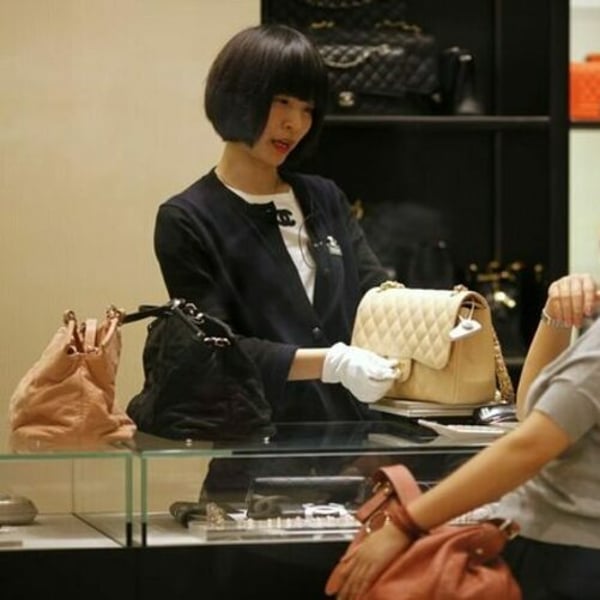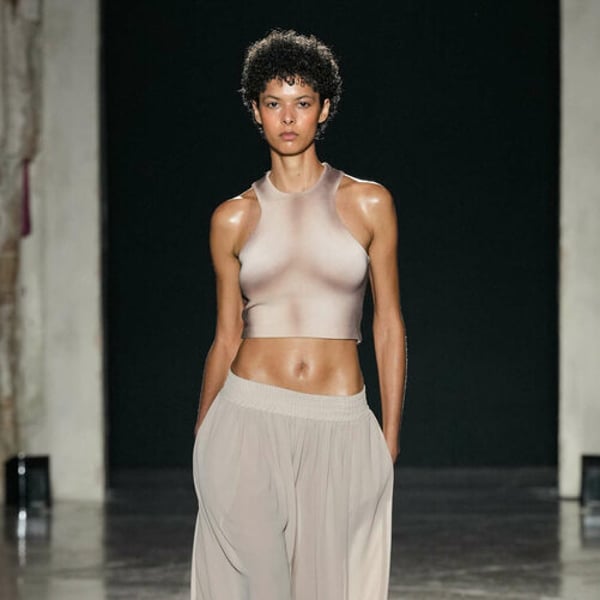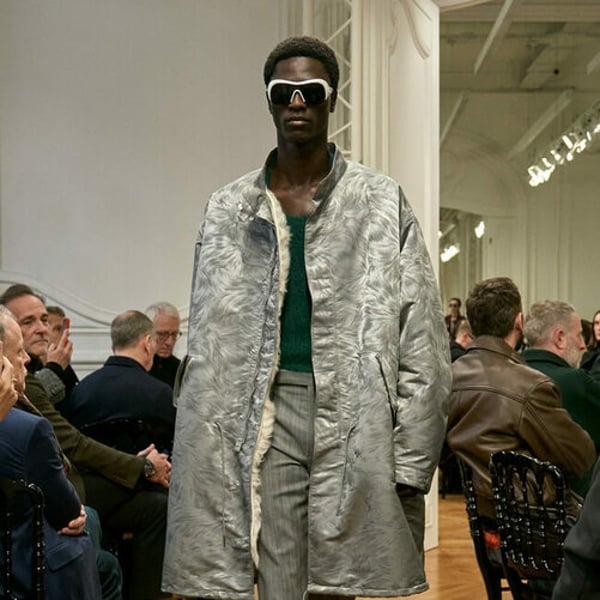Published
November 19, 2025
Although at first glance they may seem very distant aesthetically, a surprising new exhibition in Paris reveals that the most famous couturier in history and the most influential independent fashion designer of the last half century, Christian Dior and Azzedine Alaïa, respectively, enjoyed a much closer proximity than it appears at first glance.
Both stood out in fashion during their careers, although their aesthetics differed greatly. Dior invented the New Look and developed a romantic vision of haute couture, replete with floral and garden prints. Alaïa created empowered women warriors and superheroes in form-fitting, highly sculpted clothing.
Titled Dior Collection by Azzedine Alaïa, the exhibition opened Wednesday evening at La Galerie Dior, the brand's ultra-stylish museum, and presents a scenographic narrative of the history of the famous haute couture house. The show features 101 looks by Christian Dior and five of his successors: Yves Saint Laurent, Marc Bohan, Gianfranco Ferré, John Galliano and Maria Grazia Chiuri, owned by the Alaïa Foundation, possibly the largest private haute couture collection ever assembled.
Indeed, the exhibition is in tune with a parallel dialogue between Dior and Alaïa, since on December 14 a second exhibition will open at the Alaïa Foundation in the Marais, where 30 Dior looks acquired by Azzedine will be juxtaposed with his own creations.
On a professional level, the designers crossed paths, even if it was only for five days. An exposed employment contract shows that Azzedine Ben Alaïa undertook a brief internship at the Dior house in June 1956.

The genesis of the project dates back two years, when the director of the Alaïa Foundation, Olivier Saillard, realized how many Alaïa pieces had acquired from Dior and Monsieur's successor couturiers.
“When we put them all together, we realized there were a whopping 600 pieces. Wow! So we asked Dior Heritage to look at the collection and give us their expert advice,” Saillard recalls.
Finally, Dior Heritage prepared a special inventory, researching the appropriate season and collection each piece belonged to, the date the dress was made, and its exact fabrics. That same fashion detective work is highlighted by walls of exactly dated sketches by Monsieur Dior and photographs of him at work, along with panels of fabric samples, precise details about fabric makers, embroiderers, and even the name of the model who first wore the look.
“Dior Heritage ended up asking, since there are so many very important creations, would you be able to create an exhibition to present at least part of this collection? In the end, we chose 101 pieces for this exhibition here. It makes sense because Alaïa's collection is right where it started in Paris, opening the doors of Christian Dior for five days,” said Saillard.
Taking advantage of a remarkable coincidence, the exhibition opens on the eighth anniversary of Azzedine, who died at the age of 82 on November 18, 2017.

Alaïa began collecting fashion rarities in the late 1960s, long before even the great Paris houses, such as Dior, Givenchy and Chanel, began assembling their own historical collections.
“Around 1968, when Balenciaga closed its doors, Azzedine became very concerned about the preservation of great couture. In fact, he bought much more than any museum at that time in Paris. This was at a time when fashion museums simply did not have the budgets they have today,” explained Saillard, one of fashion's greatest curators and former director of the Galliera, one of the most important fashion museums in Paris.
Buying fashion and haute couture was such a passion that Alaïa ended up acquiring more than 20,000 pieces, managed today by his Foundation and kept in a secret place.
“I used to see Azzedine almost every week at auctions bidding endlessly on the most important pieces I've ever seen. And sometimes I'd shout, 'Olivier!' You have to buy this dress.” And I replied: Azzedine, I just don't have the money.” And he responded: “Call the Minister of Culture and get it! Which was not possible.”
The Tunisian designer brought together all the great masters, such as Vionnet, Balenciaga and Madame Grès. Some 900 works by the latter were the subject of another exhibition of his foundation.

Alaïa bought so many things and at such high prices (like a famous Schiaparelli dress worn by Marlene Dietrich that sold for more than 200,000 euros) that dealers worried the vintage market would collapse after her death. But the growing interest in fashion has meant that this is not the case.
The week Alaïa sold part of her house to Prada in 2000, she immediately went shopping. Buy many pieces from Poiret, the rarest and most expensive fashion designer of all.
Alaïa's family were well-off wheat farmers in Tunisia, and he discovered fashion by reading his mother's copies of French Vogue. As a result, this exhibition begins with a dress from an era that greatly influenced Dior, the Belle Epoque, and a dress like the one Christian's mother Madelaine would have worn.
“It's a reminder of the influence that so many mothers have had on so many fashion designers,” said Galerie Dior director Olivier Flaviano, who joined Saillard for an exclusive presentation of the exhibition for FashionNetwork.com.
Each look has a name, all of them placed on simple stands in practically the 14 sections of La Galerie Dior.
The opening room contains a number of early works, including one by Dior for Lucien Lelong, where he learned the couturier's trade before opening his own house in 1947. A 1950s printed nylon taffeta looks like it was made last week, while a 1951 ensemble in pleated wool could almost have been designed by Alaïa.

In other ways, these two legends are light years apart, as seen in an enchanting display of beaded floral organza and lace dresses by Dior and Chiuri, all presented in a mock garden in front of a backdrop of Granville, the seafront villa in Normandy where Christian grew up.
“Several of these dresses date back to 1956, the year Alaïa worked here. So, in theory, Azzedine could even have done a little work on one of them,” Flaviano winks.
All of Monsieur's successors have their moments. Particularly in a gorgeous black-and-white trilogy of embroidered lace and printed silk twill, where Ferré and Bohan's creations accompany a narrow-waisted New Look dress by Monsieur like two little sisters.
Saint Laurent, who barely lasted two years as Christian's first successor, enjoys a wow factor with an avant-garde bouffant cut and beveled pink dress. It is called Nuit d'Ispahan, in honor of the ancient Persian city. While Galliano, who was in charge for a decade, is represented by a bravura 2005 funnel-neck slash jacket that earns magna cum laude for its tailoring.
Ultimately, although their styles were distant, Alaïa loved Christian Dior for the simple fact that he was the embodiment of both haute couture and France, the profession and the country he adopted. Alaïa was such a Dior fan that she even bought three versions of the same dress: a bright, swirling cocktail number in silk faille titled Venezuela from 1957, the year of Dior's death. Frankly, any woman would jump at the chance to rock this look. There's a snappy Guy Bourdin photo of that same dress from French Vogue nearby. And another version from Venezuela with a spotted red floral that is simply beautiful.
“When, as a teenager, he fell in love with fashion in Tunisia, he was fascinated by Dior and by dresses that seemed to 'stand on their own.' And that is what we have tried to capture in this exhibition,” concludes Saillard.
For true fashion aficionados, this is simply an exhibition not to be missed.
Copyright © 2025 FashionNetwork.com All rights reserved.












